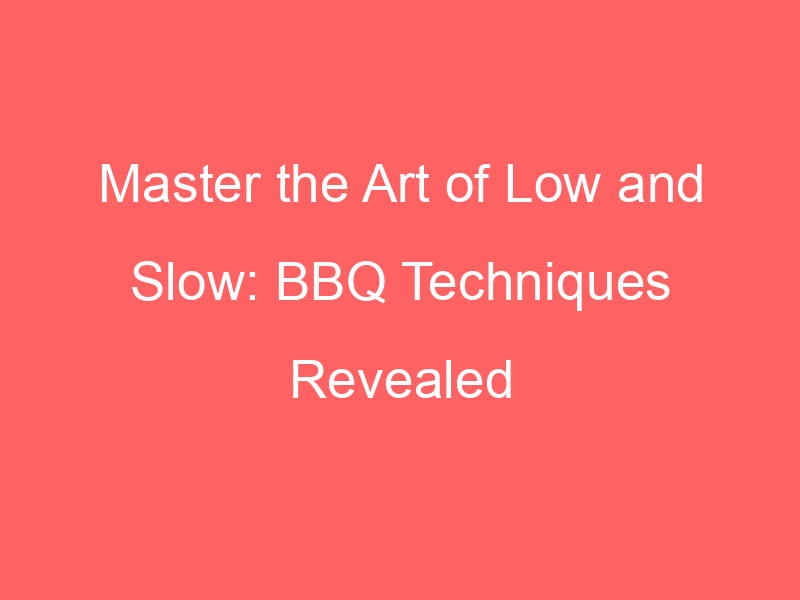Introduction to BBQ Low and Slow Cooking Methods
Hey there, BBQ lovers! Today, we’re going to dive into the delicious world of low and slow BBQ cooking. This method is all about patience, but trust us, the results are worth the wait!
- Understanding the concept of low and slow
- Benefits of low and slow BBQ cooking
Low and slow is a BBQ cooking method that’s all about taking your time. Instead of cranking up the heat and cooking your food quickly, you set your grill to a lower temperature and let your food cook slowly. This method can take several hours, but it’s the secret to getting that tender, juicy, fall-off-the-bone goodness that BBQ is famous for. Think of it like a slow cooker, but for your grill. Wikipedia has a great article on this if you want to dive deeper.
So, why should you cook your BBQ low and slow? Well, there are a few reasons. First, it makes your food super tender. The slow cooking process breaks down the tough fibers in meat, making it melt-in-your-mouth delicious. Second, it brings out the flavors. Cooking at a lower temperature allows the flavors to develop more fully. And last but not least, it’s a great way to impress your friends and family. There’s nothing like serving up a perfectly cooked, slow-cooked BBQ meal!
So, are you ready to try out low and slow BBQ cooking? Stick around, because we’ve got plenty more tips and tricks to share with you. Happy grilling!
Essential Barbecue Techniques
Hey there, grill enthusiasts! Let’s dive into some essential barbecue techniques that will take your grilling game to the next level. We’re going to focus on slow cooking BBQ tips today. Slow cooking is a fantastic way to get the most flavor out of your meat. So, let’s get started!
Slow Cooking BBQ Tips
Slow cooking is all about patience and precision. Here are three key tips to keep in mind:
- Choosing the right meat for slow cooking
- Importance of maintaining low heat
- Timing: The key to perfect slow-cooked BBQ
Not all meats are created equal when it comes to slow cooking. You want to go for cuts that have a good amount of fat and connective tissue, like pork shoulder or beef brisket. These cuts become incredibly tender and flavorful after a long, slow cook. Check out this Wikipedia article for more info on choosing the right meat.
Slow cooking is a low and slow process. You want to keep your grill at a steady low temperature, usually around 225°F. This allows the meat to cook evenly without drying out. Remember, patience is key!
Timing is everything in slow cooking. Depending on the size and type of meat, slow cooking can take anywhere from 4 to 12 hours. It’s important to monitor your meat and adjust the cooking time as needed. A good rule of thumb is to cook until the meat reaches an internal temperature of 195°F. This ensures that it’s fully cooked and safe to eat.
So there you have it, folks! These are the essential tips for slow cooking BBQ. Remember, it’s all about choosing the right meat, maintaining a low heat, and timing it just right. Happy grilling!
Low and Slow BBQ Recipes
Ready to try your hand at some delicious, low and slow BBQ recipes? We’ve got you covered! Here are three mouth-watering recipes that are sure to impress at your next BBQ gathering.
- Recipe 1: Slow-cooked BBQ ribs
- Recipe 2: Low and slow BBQ brisket
- Recipe 3: Low heat BBQ pulled pork
Nothing beats the classic BBQ ribs, especially when they’re slow-cooked to perfection. This recipe requires a good quality rack of ribs, your favorite BBQ sauce, and a whole lot of patience. The key is to maintain a low heat and let the ribs cook slowly, allowing the flavors to seep in and the meat to become tender and juicy. Check out the full recipe here.
If you’re a fan of beef, this low and slow BBQ brisket recipe is a must-try. The brisket is cooked at a low temperature over a long period, resulting in a melt-in-your-mouth texture and a rich, smoky flavor. The secret is in the rub – a mix of spices that adds an extra layer of flavor to the meat. Find the full recipe here.
For those who prefer pork, this low heat BBQ pulled pork recipe is a winner. The pork is cooked slowly over low heat, allowing it to become incredibly tender and easy to pull apart. The BBQ sauce adds a sweet and tangy flavor that complements the pork perfectly. Get the full recipe here.
Remember, the key to these recipes is patience. Low and slow is the way to go when it comes to BBQ. So, fire up that grill and get ready to wow your friends and family with your BBQ skills!
Advanced BBQ Cooking Techniques
Now that you’ve mastered the basics, let’s dive into some advanced BBQ cooking techniques! These methods will take your grilling game to the next level. Ready? Let’s get started!
Techniques for Slow BBQ Cooking
Slow cooking is a fantastic way to bring out the best flavors in your BBQ. It requires patience, but trust me, the results are worth it! Here are a couple of techniques you can try:
- Using a smoker for enhanced flavor
- Managing temperature fluctuations
Smokers are a BBQ enthusiast’s best friend. They allow you to cook your meat at a low temperature over a long period, infusing it with a rich, smoky flavor. To use a smoker, you’ll need to choose your wood chips carefully. Different types of wood give off different flavors, so pick one that complements your meat. For example, applewood pairs well with chicken and pork, while hickory is great for beef. Once you’ve chosen your wood, soak it in water for about 30 minutes, then place it in the smoker. Add your meat, close the lid, and let the smoker do its magic!
When slow cooking, maintaining a consistent temperature is key. Fluctuations can lead to uneven cooking, which is a big no-no in BBQ. To manage temperature fluctuations, make sure to preheat your grill or smoker before adding your meat. Use a grill thermometer to monitor the temperature and adjust the vents as needed to increase or decrease heat. Remember, slow cooking is all about low and steady heat, so aim for a temperature between 225 and 250 degrees Fahrenheit. Patience is key here, so resist the urge to open the lid too often, as this can cause the temperature to drop.
There you have it, folks! These advanced techniques will help you achieve BBQ perfection. Remember, practice makes perfect, so don’t be discouraged if you don’t get it right the first time. Keep trying, and soon you’ll be a BBQ master!
BBQ Low and Slow Grilling Tips
When it comes to BBQ, patience is a virtue. Low and slow grilling is a technique that can take your barbecue to the next level. Here are a couple of tips to help you master this method:
- Choosing the right grill for low and slow cooking
- Using indirect heat for slow grilling
Not all grills are made equal. For low and slow cooking, you need a grill that can maintain a consistent low temperature for a long period. Charcoal grills, like the kettle grill, are popular for this method because they allow for better heat control. Gas grills can also do the job, but you might need to invest in a good quality one to ensure it can hold the low heat. Remember, the key is consistency!
Indirect heat is your best friend when it comes to low and slow cooking. This means that instead of placing your meat directly over the heat source, you place it off to the side. This allows the heat to circulate around the food, cooking it evenly and slowly. It’s like turning your grill into an outdoor oven! This method is perfect for larger cuts of meat that need time to become tender and juicy.
Low and slow grilling might take more time, but trust me, the results are worth the wait. So next time you’re planning a BBQ, why not give it a try? Happy grilling!
Perfect BBQ Slow Cooking Techniques
Ever wondered how the best BBQ masters achieve that perfect, juicy, and tender meat? It’s all about the slow cooking techniques. Let’s dive into some real-life examples of successful low and slow BBQ.
Case Study: Successful Low and Slow BBQ
Here are a couple of case studies that demonstrate the power of patience and technique in achieving BBQ perfection.
- Case Study 1: BBQ Competition Winner’s Slow Cooking Method
- Case Study 2: Restaurant’s Popular Low and Slow BBQ Dish
Meet John, a BBQ enthusiast who won the National BBQ Championship last year. His secret? A low and slow cooking method. John believes in maintaining a steady temperature of around 225°F for several hours. He uses a digital thermometer to monitor the temperature and adjust the airflow accordingly. This method allows the meat to cook evenly, breaking down the tough connective tissues, resulting in a tender and juicy BBQ. Learn more about BBQ techniques here.
Next, let’s visit ‘The Grill House’, a popular BBQ restaurant famous for its slow-cooked ribs. The chef at The Grill House uses a combination of low heat and a long cooking time to achieve the restaurant’s signature melt-in-your-mouth ribs. The ribs are cooked at a low temperature of 250°F for about 5 hours. This slow cooking process allows the flavors to penetrate deep into the meat, making it incredibly flavorful and tender. Discover more about BBQ grills here.
These case studies prove that with the right techniques and a bit of patience, you too can achieve BBQ perfection. So, why not give these slow cooking methods a try at your next BBQ?
Key Takeaways: Mastering Low and Slow BBQ
- Patience is key in low and slow BBQ
- Understanding heat control
- Choosing the right ingredients for slow-cooked BBQ
When it comes to mastering the art of low and slow BBQ, patience is your best friend. This method of cooking is not about speed, it’s about taking your time to let the flavors develop and the meat to become tender and juicy. It can take anywhere from 4 to 16 hours to slow cook a piece of meat, depending on its size and the temperature you’re cooking at. So, sit back, relax, and let the grill do its magic!
Heat control is crucial in low and slow BBQ. The goal is to maintain a consistent temperature throughout the cooking process. This can be achieved by controlling the airflow in your grill, which in turn controls the temperature. The more air you let in, the hotter the grill will get. Conversely, less air will cool it down. It’s a delicate balance that takes some practice to master, but once you do, you’ll be able to cook your BBQ to perfection every time.
Lastly, the ingredients you choose can make or break your slow-cooked BBQ. Start with high-quality meat. It’s the star of the show, after all! Look for cuts with a good amount of marbling, as the fat will melt during the slow cooking process, keeping the meat moist and adding flavor. When it comes to seasoning, less is more. A simple rub of salt, pepper, and a few of your favorite spices is all you need. And don’t forget about the wood! Different types of wood will impart different flavors to your BBQ, so choose wisely.
Conclusion: Your Guide to Low Heat BBQ Methods
Well, folks, we’ve reached the end of our BBQ journey. We’ve learned a lot about the art of low and slow BBQ cooking. Now, let’s take a moment to recap the essential techniques and share some final tips to help you become a master of the grill.
- Recap of essential BBQ techniques:
- Final tips for mastering low and slow BBQ:
Remember, patience is the key to low and slow BBQ. It’s all about maintaining a consistent low temperature and giving your meat the time it needs to become tender and flavorful. We’ve talked about the importance of preheating your grill, choosing the right wood for smoking, and using a digital thermometer to monitor your grill’s temperature. Don’t forget about the 2-zone setup for indirect grilling, and the Texas Crutch method for speeding up the cooking process without sacrificing flavor. For more information, you can check out the Wikipedia page on BBQ.
Practice makes perfect. Don’t be discouraged if your first few attempts at low and slow BBQ don’t turn out exactly as you’d hoped. Keep trying, keep learning, and don’t be afraid to experiment. Try different types of wood, different cuts of meat, and different sauces and rubs. And most importantly, have fun! BBQ is as much about the process as it is about the end result. So grab a cold drink, fire up the grill, and enjoy the ride.
With these techniques and tips in your BBQ toolkit, you’re well on your way to becoming a grill master. So what are you waiting for? It’s time to get out there and start grilling!






